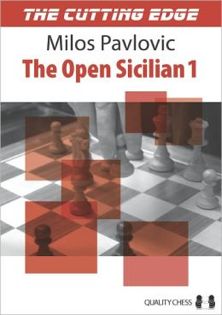The Cutting Edge
The Open Sicilian 1
Milos Pavlovic

THE CUTTING EDGE: THE OPEN SICILIAN 1 by Serbian GM Milos Pavlovic is something quite different from the THE ALTERMAN GAMBIT GUIDE: WHITE GAMBITS. This book, the first in a new series from Quality Chess, is aimed at those who want an up to date guide of where theory stands (and where it is likely to head) in important theoretical battlegrounds. There are no older games cited nor are the lines arranged to cobble together a complete repertoire. The author doesnt write for either color, letting the cards fall where they will.
This approach is something new. The analysis is more detailed and the coverage more cohesive than offered in most NEW IN CHESS YEARBOOK Surveys or at Chess Publishing.com. The lines examined are definitely more critical than those featured in the SOS series by New in Chess.
The variations covered are:
Sveshnikov 13.Nxb5 piece sac: 9.Bxf6 gxf6 10.Nd5 f5 11.Bd3 Be6 12.c3 Bg7 13.Nxb5 axb5 14.Bxb5
Sveshnikov 18.h4 pawn sac: 9.Nd5 Be7 10.Bxf6 Bxf6 11.c3 0-0 12.Nc2 Bg5 13.a4 bxa4 14.Rxa4 a5 15.Bc4 Rb8 16.b3 Kh8 17.Nce3 g6 18.h4!?
Sveshnikov: 9.Nd5 Be7 10.Bxf6 Bxf6 11.c4
Rauzer, doubled f-pawn variation: 6.Bg5 e6 7.Qd2 a6 8.0-0-0 Bd7 9.f4 b5 10.Bxf6 gxf6
Chinese Dragon: 9.Bc4 Bd7 10.0-0-0 Rb8
Dragon, 12…Re8 system: 9.Bc4 Bd7 10.0-0-0 Rc8 11.Bb3 Ne5 12.Kb1 Re8
Dragon, Topalov variation: 9.Bc4 Bd7 10.0-0-0 Rc8 11.Bb3 Nxd4 12.Bxd4 b5
Taimanov, English Attack main line: 5.Nc3 Qc7 6.Be3 a6 7.Qd2 Nf6 8.f3 Bb4 9.0-0-0
Taimanov, English Attack with 8…Be7: 5.Nc3 Qc7 6.Be3 a6 7.Qd2 Nf6 8.000 Be7 9.f3
Taimanov with 5…a6: 5.Nc3 a6 6.Nxc6 bxc6 7.Bd3
Kan: 5.Nc3 Qc7 6.Bd3 Nf6 7.0-0 Bc5
Kan: 5.Bd3 Bc5
Pavlovic does a good job of getting to the core of the lines he covers. There is enough prose to put things into context and explain what is going on, but not so much as to overwhelm the analysis which in the end is what this book is about. Everyone can analyze key opening positions with Rybka and Fritz but with THE CUTTING EDGE: THE OPEN SICILIAN you get this plus an acknowledged expert on the relevant variations who can explain the nuances and understands the sort of positions where computer engines are likely to make mistaken evaluations. This is particularly true for the chapter on the Rauzer where understanding is critically important for a variation that is sometimes played more by feel than move to move.
This chapter is much different from the others in the book in this regard.
THE CUTTING EDGE: THE OPEN SICILIAN 1 can be warmly recommended to two groups. The first is players rated above 2200 who play either side of the variations covered, and the second is fans of sharp-edged opening theory.
